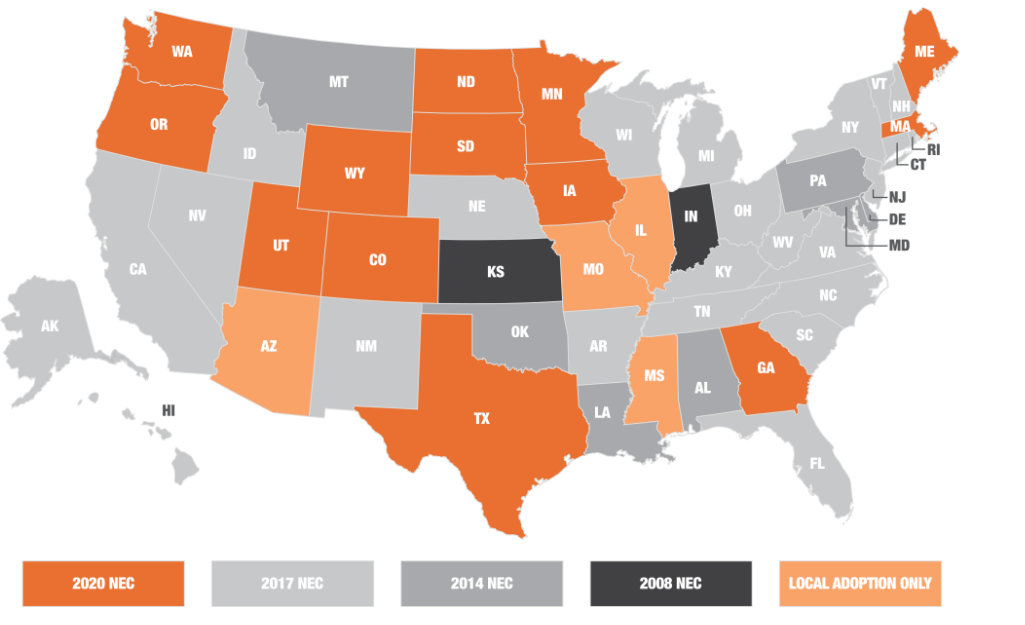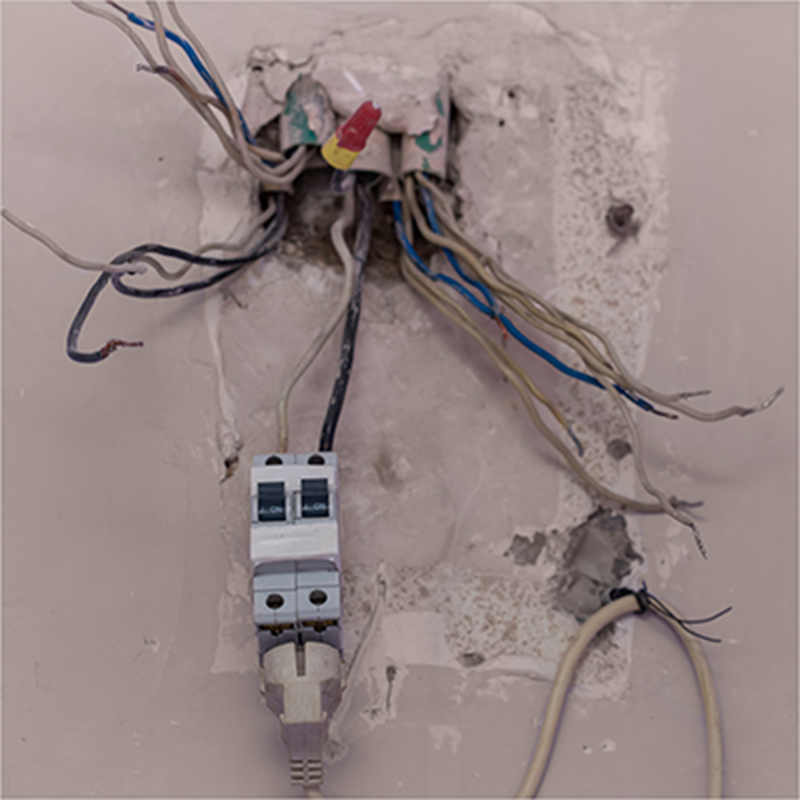NEC 2023 Code Changes

Last updated April 9, 2025
Every three years, the National Fire Protection Agency’s officially updates the National Electrical Code. Knowing the NEC’s latest changes ensures that Pros stay compliant and maintain safe practices.
The 2023 National Electric Code includes requirement updates in GFCI protection, AFCI protection, surge protection and more. This guide reviews the NEC electrical code changes for 2023, including the most recent state adoptions.
Table of Contents
NEC Electrical Code Changes for 2023
State Adoptions of NEC
NEC 2023 Updates for GFCI
More NEC 2023 Updates
New Articles in NEC 2023
More Tools. More Products. More Perks.
NEC Electrical Code Changes for 2023
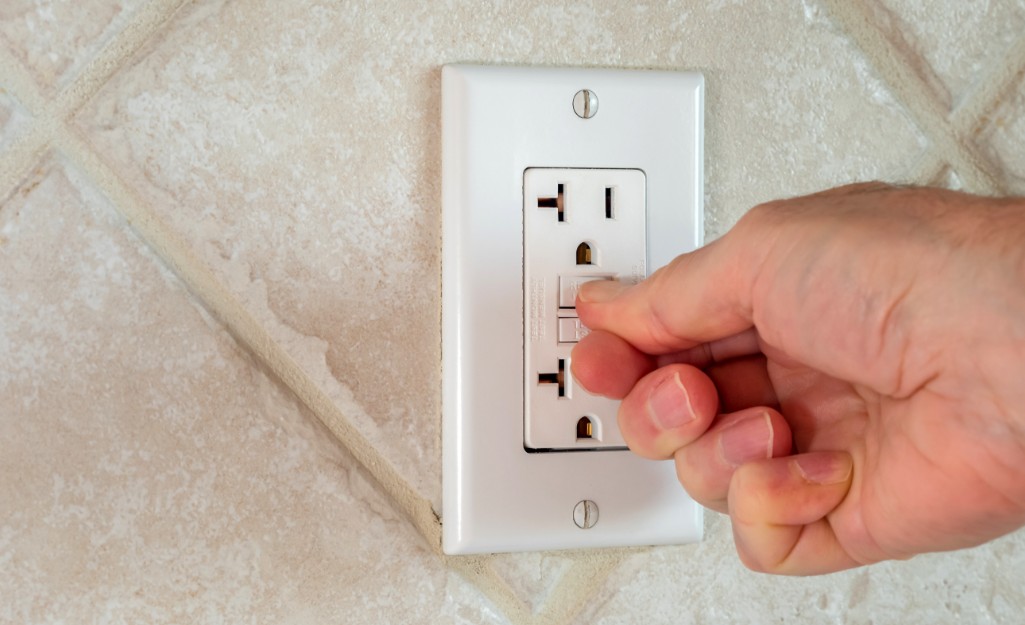
An overview of the 2023 NEC code changes includes the following:
- GFCI protection for appliances has been expanded to include wall-mounted ovens, counter-mounted cooking units, clothes dryers and microwave ovens. GFCI protection is also expanded to include any cord- and plug-connected appliance in kitchens, not just on countertops.
- A GFCI update removes the distance limitation between kitchen receptacle outlets and the sink. All receptacles in kitchen now need GFCI.
- Kitchen island countertop receptacles must be pop-ups installed in the countertop surface, not under the edge of the countertop.
- AFCI protection is now required for sleeping quarters in such dwellings as police, fire and ranger stations, in addition to previous requirements for hotels, dormitories and others.
- Surge protection is now required for multifamily dwelling units, dormitory units, guest rooms and guest suites of hotels and motels, as well as patient sleeping rooms in nursing homes and limited care facilities.
State Adoptions of NEC

Despite the name, the National Electrical Code is not a U.S. law but is commonly mandated by state or local governments. NEC 2020 included extensive revisions to the electrical code, with state adoptions represented by the map graphic above.
The NFPA Standards Council issued NEC 2023 on August 12, 2022, with an effective date of September 1 for federal, state, county and municipal governments. NEC 2020 and 2023 adoptions are indicated below.
Here is the status of NEC adoptions for the United States for both NEC 2020 and NEC 2023 as of March 1, 2025. Individual states may make exceptions or amendments to parts of the code, so confirm your local code to stay compliant:
- NEC 2023 adoption is complete in Colorado, Georgia, Idaho, Kentucky, Maine, Massachusetts, Michigan, Minnesota, Nebraska, North Dakota, Ohio, Oklahoma, Oregon, South Dakota, Texas, Washington and Wyoming.
- NEC 2023 adoption is under way and NEC 2020 adoption is complete in California, Connecticut, Iowa, New Hampshire and North Carolina.
- NEC 2020 adoption is complete in Alabama, Alaska, Arkansas, Delaware, Florida, Hawaii, Louisiana, Montana, New Jersey, New Mexico, Rhode Island, South Carolina, Utah, Vermont, Virginia and West Virginia.
- NEC 2017 is adopted in Indiana, Maryland, Nevada, New York, Pennsylvania, Tennessee and Wisconsin.
- NEC 2008 is adopted in Illinois and Kansas.
- NEC regulation occurs only at the county/municipal level in Arizona, Mississippi and Missouri.
Pro Tip: Many states set a grace period of several months between the adoption of the code and its enforcement. To stay in compliance, always confirm the NEC status of your state or municipality.
NEC 2023 Updates for GFCI
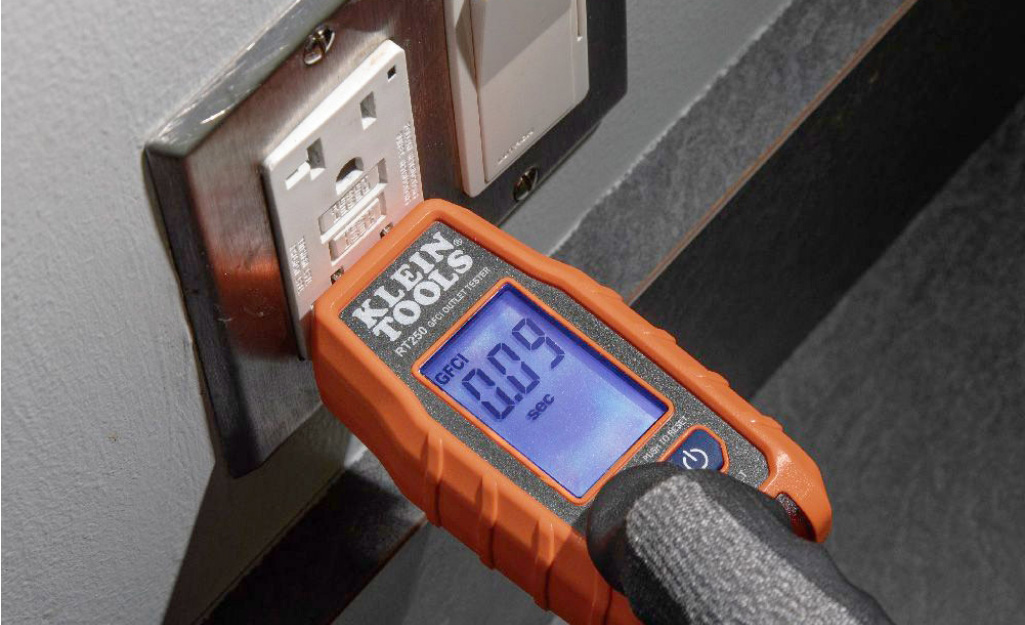
NEC 2023, particularly Section 210.8, includes multiple updates involving GFCI protection, including replacing the term “ground fault circuit interrupter” with “listed Class A GFCI.”
- Section 210.8(A)(6) removes the term “receptacles serving the countertop” to expand GFCI protection to any plug- and cord-connected appliances in kitchens. It removes the distance limitations between the kitchen sink and 125-240 volt receptacle outlets connected to single phase branch circuits, 150 volt to ground or less.
- Exception 4 states that internal receptacles in bathroom exhaust fans do not require GFCI protection unless specified by the manufacturer’s instructions.
- Section 210.8(B) requires GFCI-protected receptacles in areas with sinks and permanent provisions for cooking or food and beverage preparation, such as office break rooms.
- Section 210.8(D) expands required GFCI protection to branch circuits or outlets of electric ranges, wall-mounted ovens, counter-mounted cooking units, clothes dryers and microwave ovens.
- Section 210.8(F) requires GFCI protection for outdoor outlets rated 50 amp or less in garages and for outlets rated not over 150 volt to ground, 50 amp or less in accessory buildings and boathouses.
- Section 410.184 requires GFCI protection where horticultural lighting is connected with flexible cords that use separable connectors or attachment plugs.
- Section 680.5 requires that SPGFCI devices must be used where ground-fault protection is required for branch circuits rated over 150 volt to ground.
- Section 680.22 requires GFCI protection for all receptacles rated 60 amp or less within 20 feet of a swimming pool wall. It also requires GFCI protection for equipment installed between 5-10 feet horizontally from the inside walls of a pool. Luminaires, lighting outlets and ceiling fans between 5-10 feet horizontally from the inside walls of a pool and not less than 5 feet above the maximum water level must have GFCI or SPGFCI protection.
More NEC 2023 Updates
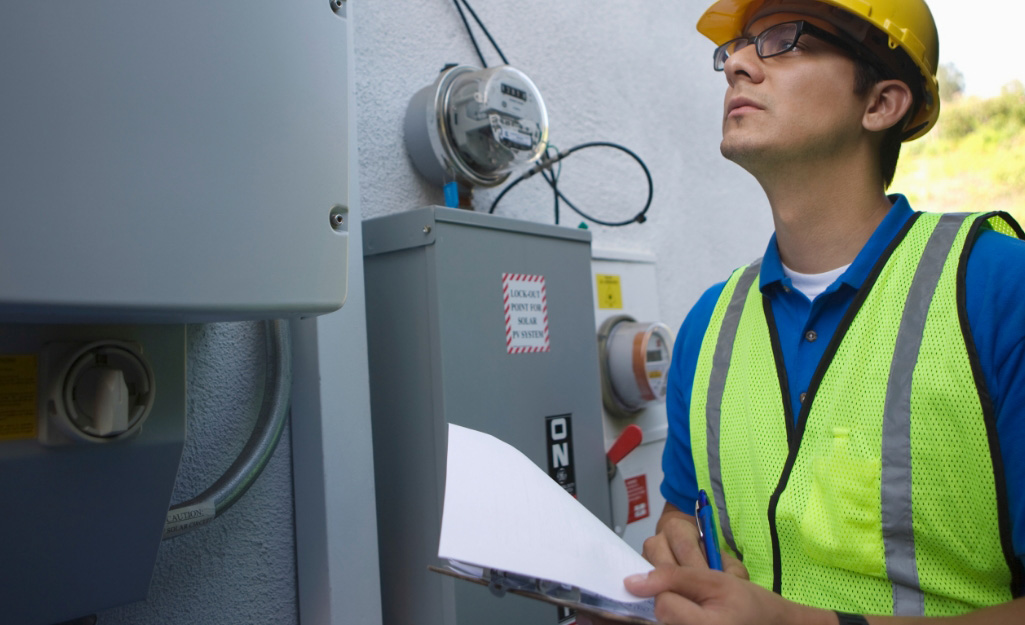
The following are additional 2023 NEC code changes:
- Section 110.26(A)(4) now requires that when electrical equipment has open doors that create an egress path less than 24 inches wide or 78 inches high, the opening must be large enough to prevent the doors from blocking the path.
- Section 110.3 adds cybersecurity to the standards for judging the safety and performance of electrical equipment.
- Section 210.12(D) extends requires for AFCI branch circuit protection to sleeping quarters in fire stations, police stations, ranger stations and similar locations.
- Section 210.17 requires that branch circuits must be installed in guest rooms and guest suits with permanent provisions for cooking in hotels, motels and assisted living facilities.
- Section 215.15 requires the placement of protective barriers so that no energized phase busbar or terminal will be exposed in equipment supplied by feeder taps or transformer secondary conductors. This can reduce hazards for maintenance workers during servicing or maintenance.
- Section 125.18 requires the installation of a surge protection device in dwelling units, dormitory units, guest rooms and guest suites of hotels and motels, as well as patient sleeping rooms in nursing homes and limited care facilities.
- Section 220.70 allows the use of digital energy management systems to limit the maximum current used by the electrical system.
- Section 225.41 requires that feeders supplied to one and two-family dwelling units have outside emergency disconnects that are clearly labelled. This allows first responders to disconnect power on the outside of a dwelling in case of emergency.
- Section 406.12 requires tamper-resistant receptacles in childcare facilities, dormitories, boathouses, mobile homes and motel rooms. It makes an exemption for single receptacles for single appliances or duplex receptacles for two appliances that are not readily accessible.
- Section 440.11 requires that, in residential spaces where unqualified persons can readily access the means to disconnect an air conditioner, the disconnect enclosure or the hinged door that exposes energized parts must be capable of being locked or require a tool to be opened.
- Section 511.7 changes requirements for wiring and equipment installed above hazardous locations and allows rigid metal conduit, intermediate metal conduit and electrical metallic tubing.
- Section 555.4 requires that service equipment for a marina or floating dock must be on land no closer than 5 feet horizontally from the water and no less than 12 inches above the electrical datum plane (EDP).
- Section 555.15 states that modification or replacement of electrical enclosures, devices or wiring on a docking facility must comply with provisions of the electrical code, and that the installation requires an inspection of the circuit. In addition, existing equipment that has been damaged must be identified, documented and repaired by a qualified person to the minimum requirements of the code to which it was originally installed.
- Section 555.36 requires that marina power outlets or enclosures that provide power to boats must have a listed emergency shutoff device or disconnect marked “Emergency Shutoff.”
- Section 625.50 requires that electric vehicle supply equipment rated greater than 16 amps or 120 volts must be supplied by an individual branch circuit. Single branch circuits are permitted to supply more than one electric vehicle supply equipment when the loads are managed by an energy management system.
- Section 625.49 permits electric vehicle power export equipment (EVPE) and bidirectional electric vehicle supply equipment (EVSE) that incorporate a power export function to be a part of an interconnected power system that can operate in island mode. (“Island mode” is sometimes called “off the grid” or “back-up mode.”)
- Section 700.11 provides voltage requirements for emergency lighting systems. Class 2 power-limited emergency circuits must be permanently marked as components of an emergency circuit or system.
New Articles in NEC 2023
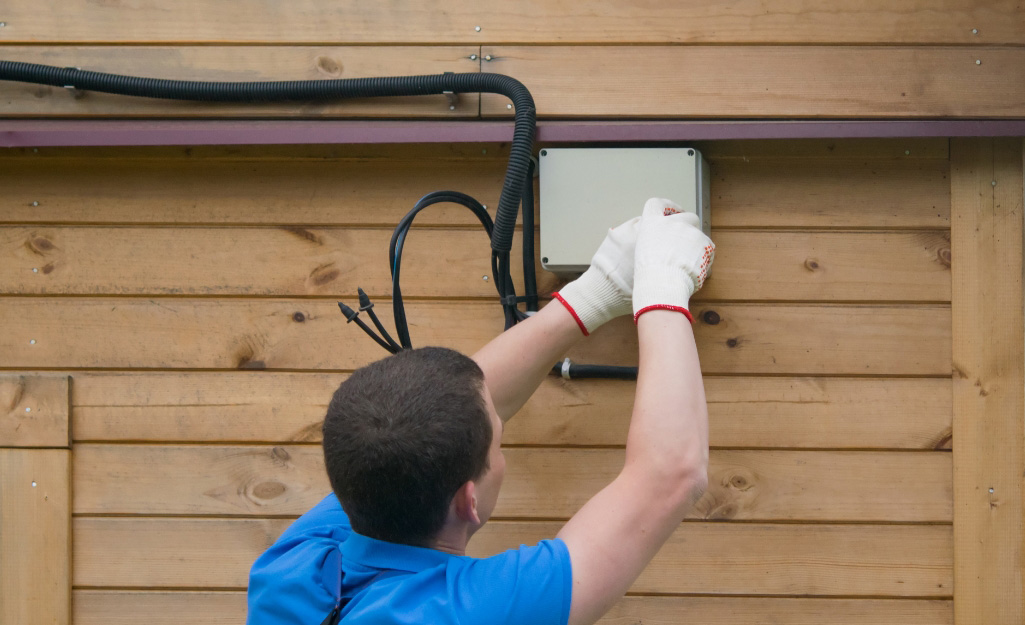
NEC 2023 adds several new articles. Multiple articles were added to organize and provide more guidance for medium voltage installations:
- Article 235 addresses branch circuits, feeders and services over 1,000 VAC, 1,500 VDC, nominal.
- Article 245 addresses the installation of overcurrent protection for systems rated over 1,000 VAC, 1,500 VDC.
- Article 305 (replacing Article 399) addresses general requirements for wiring methods and materials for systems rated over 1,000 VAC, 1,500 VDC, nominal.
- Article 315 (replacing Article 311) adds installation requirements for medium voltage conductors, cable, cable joints and cable terminations.
- Article 495 addresses equipment over 1,000 VAC, 1,500 VDC, nominal.
Other additional articles include the following:
- Article 369 addresses the installation of insulated bus pipe (IBP), also known as tubular covered conductor (TCC) systems. It requires IBP to be listed, installed, supported and tested by qualified persons to the manufacturer’s instructions.
- Article 371 addresses the use and installation requirements of flexible bus systems based on copper bus covered with insulation.
- Article 372 addresses cabling rules for power-limited circuits, fault-managed power circuits and optical fiber.
- Article 520 addresses cannabis oil equipment and systems using flammable materials in commercial and industrial facilities.
- Article 724 addresses Class 1 power-limited circuits and Class 1 power-limited remote-control and signaling circuits.
- Article 726 addresses Class 4 fault-managed power systems.
NEC 2023 removed several articles from NEC 2020 to eliminate redundancies. These include:
- Article 510 on Hazardous (Classified) Locations-Specific
- Article 712 on direct current microgrids
- Article 720 on circuits and equipment operating at less than 50 volts
More Tools. More Products. More Perks.

Be more competitive and boost your bottom line with Pro Xtra, The Home Depot’s free loyalty program built for Pros. Sign up today to access the enhanced Pro Online Experience, built with the online business tools and time-saving features Pros need.
Authorize employee in-store purchases quickly and securely via text. When Pro Xtra members enroll in Text2Confirm, you have total visibility to a detailed list of everything your employee is buying.
The information on this page is provided only for general reference. The National Fire Protection Association develops and publishes the NEC. Home Depot does not provide information on how changes to the NEC might affect your work. Please consult with local code authorities or other licensed professionals concerning specific questions relating to the NEC or the changes in the 2023 NEC.






